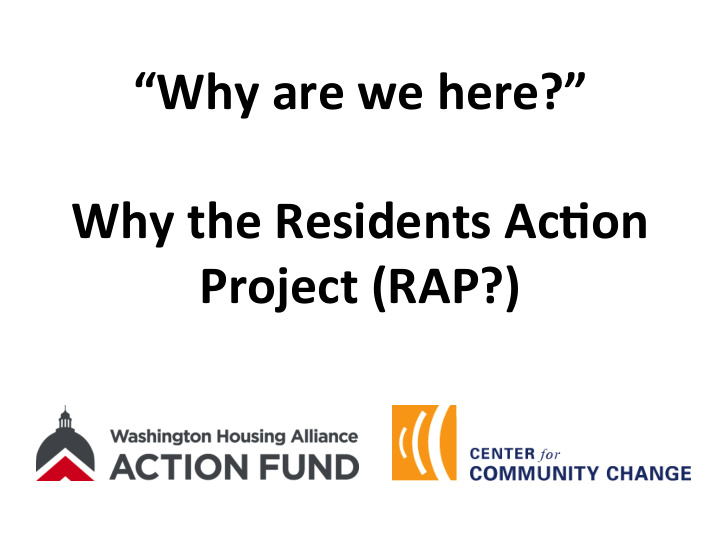



“Why are we here?” Why the Residents Ac4on Project (RAP?)
Housing Today
Wages are not keeping up with rent increases.
Who is le8 out of Washington’s housing market? Who is being left out of Washington’s Housing Market? 50% of State Median Household Income in 2014: $30,683 Job Category Annual Mean Wage in WA Cashiers $26,290 Home Health Aids $26,070 Nursing Assistants $29,250 Restaurant Cooks $26,180 Food Preparation, Serving, and Fast $22,230 Food Workers Amusement and Recreation $23,140 Attendants Childcare Workers $23,260 Maids and Housekeeping Cleaners $23,890 4 Sources : Bureau of Labor Statistics and http://www.deptofnumbers.com/income/washington/
Need for Affordable Housing By Region Affordable and Available Units Affordable and Available Units per 100 Households 0 - 30% of per 100 Households 0 - 50% of Region Median Family Income Median Family Income Washington State 28 51 Cowlitz County 19 47 Grant County 26 46 King County 15 34 Pierce County 10 29 Snohomish County 16 37 Spokane County 12 37 Yakima County 16 39 Source: State of Washington Housing Needs Assessment , Department of Commerce. January 2015.
Despite the great need for affordable housing, funding sources have greatly decreased. Change in Washington’s Major Affordable Housing Funding Sources FY 2007/-8 to 2012/13 Funding Sources FY 2007/08 FY 2012/13 % Change State Housing Trust Fund $191,000,000 $112,900,000 -41% Federal CDBG Funds $456,494,879 $367,204,607 -20% Federal HOME Funds $236,393,040 $127,115,742 -46% Total $883,887,919 $607,220,349 -31% Source: CHPC tabulations of HCD’s Annual Report of Financial Assistance Programs and Redevelopment Housing Activities Report, and HUD’s CPD program formula allocations by fiscal year; WLIHA Data
WHY? UNDERSTANDING & GAINING POWER
What is Power? • Power – To Be Able • “Power concedes nothing without demand. It never has and it never will.” – Frederick Douglass • Power = Organized People, InformaFon and Money
FORMS OF POWER EXERCISE
Forms of Power Individual power: ability of any individual to ‘control’ their environment/circumstances
Forms of Power PosiMonal power: authority that one yields over a subordinate [parents to kids, boss to employee, etc…]
Forms of Power InsMtuMonal power: power that sits within the societal structures [government, churches, schools, etc…] that have influence over people’s lives
Forms of Power LegislaMve Power: ability to get decision makers to vote or support a certain policy. Measured in votes, money, & Mming (most effecMve prior to elecMon).
Forms of Power Ideological power: hegemony - the success of the dominant group in presenMng their definiMon of reality/their view of the world, in such a way that it is accepted by others as 'common sense'. The general 'consensus' is that it is the only sensible way of seeing the world. Any groups who present an alternaMve view are therefore marginalized.
Power in Housing History History of Oppression and Resistance
History of Oppression 1930’s Federal Government & Redlining 18
Seadle Today
A racial covenant from Capitol Hill: “ No part of said premises shall ever be used or occupied by or sold, conveyed, leased, rented, or given to negroes or any person or persons of negro blood.” Green Lake: “Said tract shall not be sold, leased, or rented to any person or persons other than of white race nor shall any person or persons other than of white race use or occupy said tract.” 20
Materials can be found in Urban Strategies Council’s Building an Indicator Base for Healthy Housing in Oakland (2013) report
Between 1934 and 1964, 98% of the home loans that are insured by the federal government go to white Americans 22
1950s & “urban renewal” aka negro removal
1950s-1970s Freeway Expansion
Racist policies succeed in creaMng segregated communiMes! 25
Increased # of subprime mortgages in communiMes of color “Statewide, mortgages in lower-income neighborhoods were almost twice as likely to be high-cost than those in higher-income neighborhoods.”
GentrificaMon Odessa Brown - a clinic that treats sickle cell disease in the Central District in Seadle - has become increasingly inaccessible to those who need it because they’ve been priced out of the community. Source: http://features.crosscut.com/odessa-brown-and-the-fading-african-american-seattle
History of Resistance 28 ’65-’68 Riots & the Kerner Commission Report
The Kerner Commission’s Report 29
George Romney vs. the U.S. President “We must have open housing on a statewide basis. Zoning that creates either large-scale economic or racial segregaFon should be eliminated. We must provide low cost private housing through nonprofit organizaFons in all parts of the metropolitan area and throughout the state. “ 30
Fair Housing Act 31
Discussion QuesMons • Has your family been impacted by any of these discriminatory policies? Which ones? In what ways has it impacted your life? • What can we do to turn the Mde of discriminatory policies? • Dream big, what policy (or law) would you like so that your community benefits?
We need soluMons! Where do we start? Resident Ac4on Project (RAP) Building Power through Community Organizing!
Women’s Suffrage
Bus Boycod
Marriage Equality
Affordable Housing
Recommend
More recommend